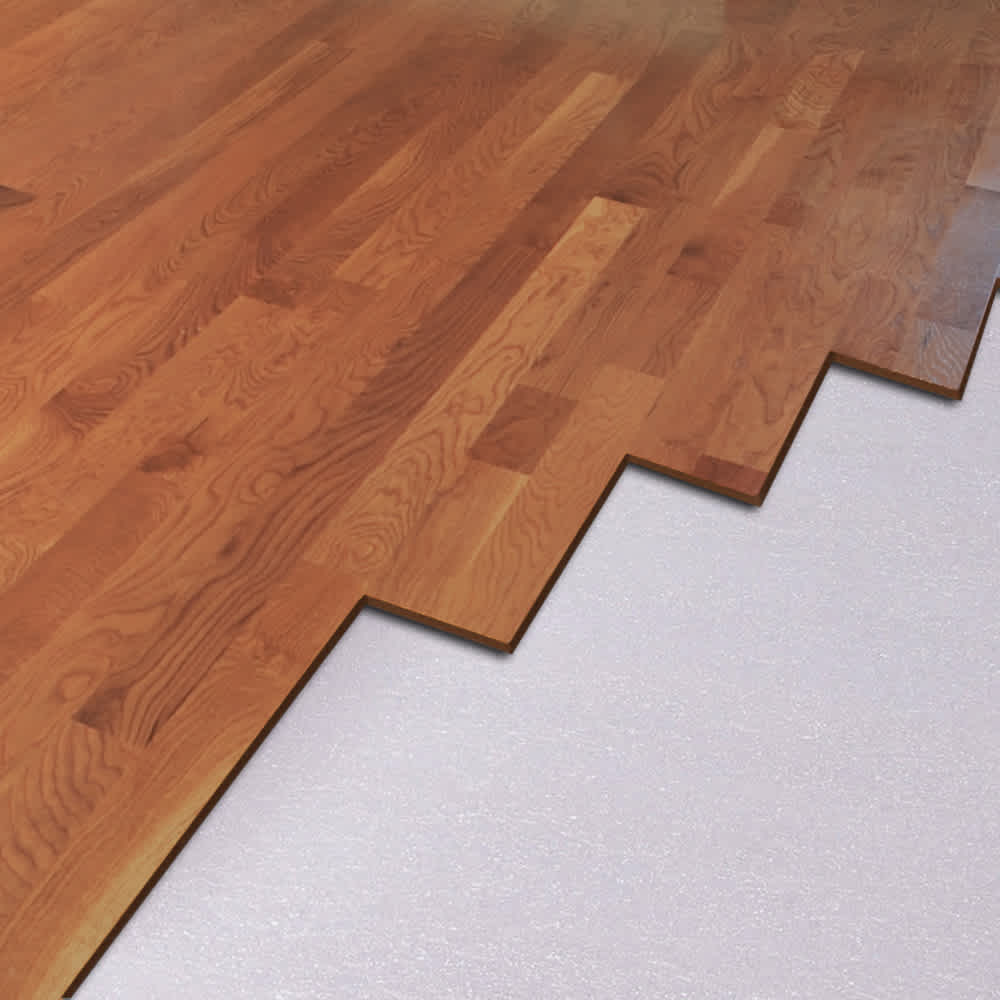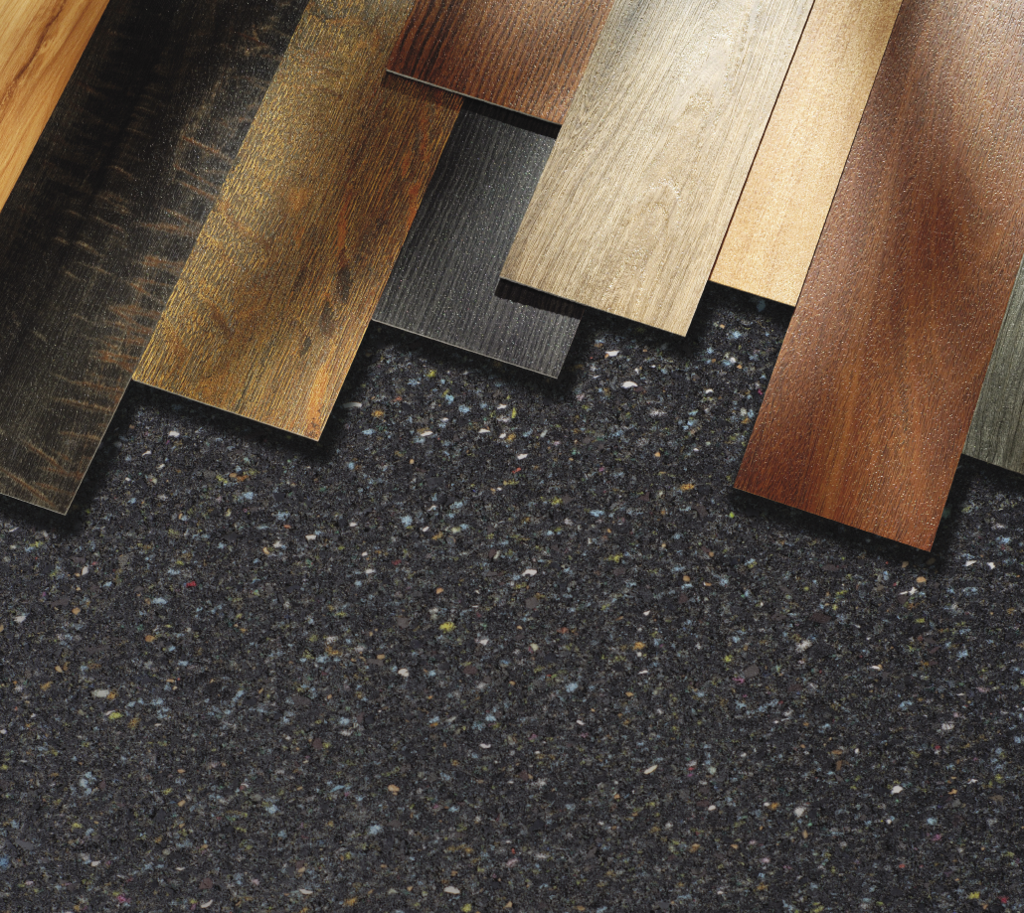Underlayment

There are a lot of decisions to make during your floor buying journey. You must choose flooring thickness, the color, and the size. A big consideration is whether or not you need underlayment. Underlayment is a key accessory that is often overlooked. So, what exactly is it, and do you actually need it? We’ve put together a buyer’s guide with all the facts and answers to your questions to help you make the right choice.
What is Underlayment?
Underlayment is a crucial piece to having great flooring; it is the layer between your subfloor and your new floor. There are different forms of underlayment such as rubber, cork, felt, and foam.
Underlayment is an easy way to protect your flooring investment. This extra piece adds a layer of security to keep your floor from cracking or wearing down. It also adds warmth in the colder months and a bit of softness. Simply put, underlayment flooring is a simple solution to adding both comfort and protection.
Why Do You Need Underlayment?
Underlayment rubber flooring may be thin, but the small layer provides huge benefits to new floors. Underlayment flooring serves as a protective barrier between your new flooring and your subfloor by preventing friction and shifting. Here’s a look at some other big advantages of using underlayment:
-
Provides stability
-
Muffles sounds
-
Helps your subfloor stay down correctly
-
Adds softness to your flooring
-
Helps protect your subfloor against moisture
-
Provides a barrier of sound between different levels
-
Adds warmth
-
And more!
Types of Underlayment
In some cases, your flooring will come with an attached underlayment. If it doesn’t, then you’ll definitely want to invest in buying this protective layer on its own. There are several different types of underlayment to choose from and we can provide them for you. The underlayment you need will all depend on what type of flooring you are installing and where.

Rubber
Is sound absorption on the top of your list when it comes to your flooring? If so, rubber is your flooring choice! Rubber underlayment offers the best sound absorption. This underlayment is also water-resistant, so it can be used in basements or other areas where water may be present or condensate. It works best for stone, hardwoods, and garage tiles. However, you won’t want to use this with vinyl or linoleum floors because it can stain.
Another great thing about rubber underlayment is that it is made from recycled tires that are kept out of landfills across the country. So, it’s eco-friendly, too!

What Underlayment is Best for Your Floor?
The underlayment you need depends on the type of flooring you install. Each underlay offers its own benefits, from sound absorption to comfort. Let’s explore the different types of flooring and find an underlayment that works best for you:
For Laminate
Foam is the best underlayment for laminate flooring. There are several different foam underlay options to choose from, depending on your needs. If your new flooring will be installed in an area that is prone to moisture, then you will also want to get a vapor barrier.
For Vinyl
Cork is the best underlayment when it comes to vinyl. Foam and felt are other great options and won’t stain like rubber or rubber cork will. With some vinyl flooring, an underlayment may not be required, or even allowed. In fact, some manufacturers may void warranties if certain underlayments are used. Just to be safe, check with your warranty before you purchase your underlayment.
For Carpet
Foam or rubber are most often used for carpet underlayments. These underlayments come in a variety of thicknesses that can help make your floor even more comfortable to walk on. You’ll at least want ¼” of padding under residential carpet to absorb sound.
For Tile
Rubber cork underlayment is designed for crack suppression. This makes it a great underlayment to use with thin tiles. When your foundation shifts, causing your subfloor to crack, and your tiles will stay safe.
For Wood
Cork and foam are the chosen favorites for wood flooring. Since foam has more give to it, we recommend going with an extra dense grade. However, cork has less give to it, so it will stay be more sturdy under your hardwood planks.
The Thickness of Underlayment
Thickness is important when choosing your underlayment. However, just because an underlayment is thick, doesn’t mean it will still provide the best density.
Here are the most common thicknesses used for underlayment flooring:
2-3mm is the most common thickness in underlayments. In some cases, you may need something thicker to use with carpet underneath or to smooth out an uneven subfloor.
If you’re unsure what thickness to go with, it’s a good idea to check with the manufacturer to see what they recommend. You can also reach out to our expert team at RubberFlooring4U.com, we're happy to help find an underlayment that will work for your flooring needs.
How to Install Underlayment?
Underlayment is easy to install and you can do it all yourself! All you need is a few tools and some time. Of course, it’s always a good idea to check with the manufacturer to see if they have any specific directions or helpful tips. But here are the basic steps to have your underlayment flooring installed:
-
Roll the underlayment out, one row at a time, perpendicular to the direction the flooring will be laid.
-
Connect the rows at the seams. Use tape or the adhesive strips that are included on the underlayment.
What is the Price of Underlayment?
It is hard to give an exact price for your underlayment, because there are so many different types you can get. Generally speaking, foam is the cheapest, rubber is usually the median of pricing, and cork is the most expensive. If you need different features like a built-in moisture barrier, then you can expect the price to go up.
Get Started with Underlayment Today
Make the most out of your flooring investment with high-quality underlayment flooring from Rubber Flooring 4U. We guarantee, when you buy underlayment from us, you will get it at the best price possible. We price match our competitors! And you’ll get the best lead time in the industry because we have a great relationship with our manufacturer; our customer is our priority.
And that’s not all - when buying underlayment rubber flooring from Rubber Flooring 4U, you are helping to keep tires out of the landfill. Our flooring is made from recycled tires by our hard-working manufacturer that is right here in the USA. So, not only are you helping to keep our country cleaner, but you are providing jobs in our great country, too. That’s something we are proud of, and you should be too!
Don’t wait, order your underlayment today! Our employees offer the best customer service in the industry and are here to help. Experience the Rubber Flooring 4U difference today. Give us a call at (800) 936-1287 and get started today.
Underlayment FAQs
An underlayment is the key piece to a great floor. You want to make sure you have the best underlayment to protect your flooring investment. We’ve put together a list of the most frequently asked questions to make your shopping experience easier and your decision be just as simple.
Why should I use underlayment with my flooring?
Underlayment is a great solution to reduce noise, provide insulation, and add extra comfort to your flooring. It also prevents cracks in your floor and keeps your flooring safe as well.
Will underlayment prevent cracks?
Rubber, cork, and rubber cork underlayment have crack suppression to protect your flooring during shifting and foundation movements. Between the three options, rubber cork provides the ultimate crack suppression.
Do I need to purchase additional underlayment if my flooring has an attached underlayment?
If your flooring has an underlayment attached, an additional underlayment is not required. In fact, sometimes, doubling up on underlay can cause damage to your floor.
What is a moisture barrier?
You may sometimes hear a moisture barrier referred to as a ‘vapor barrier’. These are the same product and are identical when it comes to uses. These barriers prevent moisture from your subfloor from passing through to the flooring you have installed. These are most often used in basements and other areas prone to moisture or condensation.
What can I do to make my floor quieter?
If you’ve added underlay during installation, but you still want your floor to muffle more sound, you may want to consider adding area rugs.
